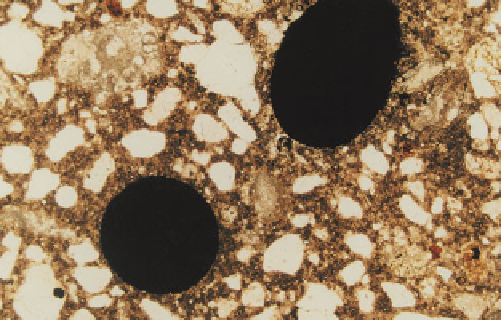Geoscience Reference
In-Depth Information
cement with two mineral additions to produce high-
strength or high-performance concrete. These are usually
blends of cement and silica fume (typically around 5%)
with either GGBS or PFA as the third component (20-
50%). While the petrographer will easily observe the
presence of GGBS or PFA, the silica fume will most likely
go undetected in thin section.
Inert limestone fillers are being increasingly used in
concrete (added to the cement or at the mixer). EN 197-
1 (British Standards Institution, 2000a) contains two
types of Portland-limestone cement containing either 6-
20% or 21-35% limestone filler. In thin section,
limestone filler is observed as highly birefringent calcium
carbonate dust (typically <75 μm sized particles). When
the concrete contains limestone aggregate, care must be
taken not to confuse limestone filler with dust of fracture
from the aggregate (
177
).
Modern concrete mixes are usually designed to
include one or more chemical admixtures to modify the
fresh or hardened concrete properties. Admixtures are
supplied as powders or aqueous solutions and dosage
levels are low, typically being 0.3-1.5% by weight of
cement. Admixtures are used variously to improve
workability and lower the water demand of the mix
(plasticizers/superplasticizers), retard or accelerate the
rate of setting, confer air entrainment, or add
waterproofing qualities.
Chemical admixtures cannot be directly observed
using optical microscopy, although their presence may
sometimes be inferred from their effect on the concrete.
For example, air-entraining admixtures will confer the
presence of substantial quantities of small (10 μm to 1
mm diameter), spherical air voids, throughout the cement
matrix (see
185
). Infrared spectroscopy is the method of
choice for identifying the presence of organic chemical
admixtures in concrete. However, given the relatively
small dosage rates of admixtures, their detection cannot
be guaranteed. Determination of the quantity of
admixture used is particularly difficult and requires
comparison with use of specially formulated reference
samples.
Fibre-reinforced concrete contains discontinuous
discrete fibres to reduce shrinkage and improve a variety
of properties, including flexural toughness, impact
resistance, and resistance to spalling and delamination.
Fibres of various shapes and sizes made from either steel,
plastic, glass, or natural materials are used. The most
common are steel macrofibres which usually comprise
<2% of the concrete. Figure
178
shows fibre-reinforced
concrete from a floor slab that incorporates round steel
macrofibres (0.75 mm diameter). The appearance of
polypropylene microfibres is illustrated in Figure
327
.
W
ATER
/
CEMENT RATIO
The ratio of water to cement in a concrete mix has a
considerable influence on the strength and durability of
the hardened concrete. For a fully compacted concrete, its
strength is inversely proportional to the water/cement ratio
(W/C) (Neville, 1995). Water is added to the mix, firstly, to
hydrate the cement and, secondly, to make the concrete
177
178
177
Concrete made with limestone aggregate (light
brown). The uncarbonated cement matrix appears
black and contains limestone dust from the aggregate
(light brown) and relict cement grains (grey/yellow);
PPT, ×150.
178
Fibre-reinforced concrete containing round steel
macrofibres (black). One fibre (lower left) is seen in
cross-section while another (upper right) is seen in
oblique section; PPT, ×35.





